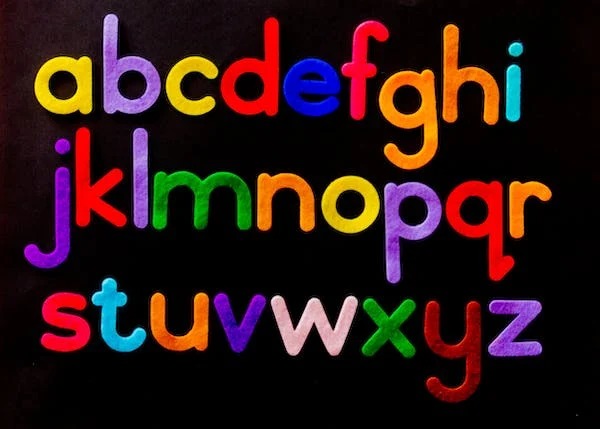Where do the fonts we use come from? Which fonts are easier to read? Why are there so many fonts? Let us discuss the history of fonts and what it means for us.
Typeface
Fonts do not exist alone, they are a part of a larger family often called typeface. And the typeface is a product of culture and technology.
A typeface is the design of lettering that can include variations, such as extra bold, bold, regular, light, italic, condensed, extended, etc. Each of these variations of the typeface is a font.
Today we have more typefaces than we can count, but really use only very few fonts, like Helvetica and Calibri. All of these fonts share similar qualities: they are very readable in all resolutions. The letters kind of look bigger than they are. These fonts are also “business casual”: professional and seemingly effortless. Most of the popular typefaces were designed by Microsoft and shipped with Windows operating system.
When I was younger the most useful fonts were Times New Roman and Arial. Arial was commissioned by IBM to avoid royalties for Helvetica. Times New Roman developed from Gamanod, a classical 17th-century French typeface.
Nobody knows the future, but a geometric post-modern font Futura is gaining popularity. If your customer wants readers to see it as ultramodern or futuristic, this is the accepted choice to make.
Blackletter typefaces
Typefaces developed with the introduction of the modern printing press from medieval calligraphy. The first typefaces in Europe were blackletter or gothic scripts. These scripts were popular throughout Western Europe from approximately 1150 until the 17th century. The fat juicy letters of gothic fonts worked well with not-so-sharp quills and the initial devices and materials of the printing presses.
The initial gothic literals were tall and beautiful Calolingian scripts, which were created with gothic churches and the first universities. Unfortunately, this script was very effort-intensive and was replaced by more competitive fonts.
Textualis, also known as textur or Gothic bookhand, was the most calligraphic form of blackletter, and today is the form most associated with “Gothic”. Johannes Gutenberg carved a textualis typeface – including a large number of ligatures and common abbreviations – when he printed his 42-line Bible. However, textualis was rarely used for typefaces after this.
Search online for “Guttenberg textura font” and you will get several font snippets. You will notice that it has a lot of unnecessary beautifications and is pretty hard to read.
From the 16th century and until the 20th century in Germany two simpler font families were used: Schwabacher and Fraktur.
Despite the frequent association of blackletter with German, the script was actually very slow to develop in German-speaking areas. It developed first in those areas closest to France and then spread to the east and south in the 13th century. The German-speaking areas are, however, where blackletter remained in use the longest.
Today’s bold and strong fonts (Control+B in some text editors) are inspired by blackletter fonts, featuring thick lines that really stand out. However, the font’s weight should not be confused with the font’s design. In each popular typeface, we will find several bold fonts.
Roman type
During the Renaissance, calligraphers tried to revive the original Roman fonts like Antiqua. Letters are designed to flow and strokes connect together in a continuous fashion; in this way it is often contrasted with Fraktur-style typefaces where the individual strokes are broken apart.
Why was it developed? The beautiful blackletter typeface was old, scholastic, and tiresome. It was difficult to read and write for a long time. So a new, simpler font was synthetically developed. By renaissance standards, writing should be simple, clear, and orthographically correct (Petrarch). So calligraphers humanists developed a new typeface: Venetian font.
The new script was relatively simple, cursive, clear, and somewhat rounded.
Soon after, typographers generated a printed form of a similar typeface, called Roman type. Once again, it was a synthetically developed script. During the renaissance, it was separate from Italic types, but now they merged.
Italic types
There are also many different forms of cursive writing. From the 13th century, cursive versions of the blackletter fonts appeared all over Europe. Between 13th and 16th century cursive letters were essentially blackletter scripts. Then they were replaced by Italics.
In typography, italic type is a cursive font based on a stylized form of calligraphic handwriting. Owing to the influence of calligraphy, italics normally slant slightly to the right.
We often use Italian fonts per each common typeface (Control+I in some text editors), to emphasize the stuff that is different. We know the people that designed these fonts: Aldus Manutius and Ludovico Arrighi.
Since the italics are basically cursive fonts, they inherited certain lines and slants. While the gothic fonts did not use serif, Italian fonts usually appeared with serif to neaten the ends of lines chiseled in typeface stones.
Basically, serifs helped created a cleaner typeface reducing irregularities at the end of lines by adding a small stroke at the end of a large stroke. Since today we do not use stones for typefaces, the majority of the popular fonts are sans-serif. There are notable exceptions, like Times New Roman.
Thick and thin lines
The old typefaces were Gothic, Italian, and Roman. By the 18th century, there was a need to introduce new fonts.
Didone, or modern, serif typefaces, which first emerged in the late 18th century, are characterized by extreme contrast between thick and thin lines. These typefaces have vertical stress and thin serifs with a constant width, with minimal bracketing (constant width). Serifs tend to be very thin, and vertical lines very heavy.
Bodoni, Didot, and Walbaum, developed typefaces that remain in use today. Didone typefaces came to dominate printing by the middle of the nineteenth century, although some “old style” faces continued to be sold and new ones developed by typefounders.
These typefaces were developed as a sort of advertising, to dazzle the observer. Publications were competing fiercely for readers and the fat fonts caught focus.
Unfortunately, while great for catching attention, these exaggerated fonts were not very pleasant for long reading. A sort of lifeless typographic nightmare.
Helvetica
Helvetica (which means Swiss) or Neue Haas Grotesk is a widely used sans-serif typeface developed in 1957 by Swiss typeface designer Max Miedinger. Basically, it is a neo-gothic font: without serifs, with uniform line width, clear and easy to read.
The font and its derivatives are extremely popular today. Each year it is adapted to another language. This is a work in progress…
What I like in this form is its minimalistic clarity: it does not have anything unnecessary, yet it has everything required to distinguish letters from one another.
The font is tight, easy to read from distance, with wide capital letters. The main disadvantages: ‘i’ and ‘l’ look very similar, and very narrow letters require good resolution of the display.
Helvetica is probably the most popular typefaces today. Microsoft designed Calibri like its business-friendly version of Helvetica. Another similarly famous font is Arial, designed by IBM to avoid royalty payments.
Verdana
The next generation of typefaces was specifically designed for Microsoft in 1990s. The letters are friendly for low-resolution displays.
For sans-serif font, Verdana was proposed.
Like many designs of this type, Verdana has a large x-height (tall lower-case characters), with wider proportions and looser letter-spacing than on print-orientated designs like Helvetica. The counters and apertures are wide, to keep strokes clearly separate from one another, and similarly-shaped letters are designed to appear clearly different to increase legibility for body text. The bold weight is thicker than would be normal with fonts for print use, suiting the limitations of onscreen display…. The availability of Verdana is 99.70% on Windows, 98.05% on computers running Mac OS, and 67.91% on free operating systems like Linux.
As a serif font, Microsoft designed Cambria in 2007. This font is italics-friendly and useful with formulas for mathematic and scientific texts as a replacement for Times New Roman. Cambria is distributed with all Windows versions since Windows Vista and on TeX-based platforms.
Geometric fonts
Futura is a geometric sans-serif typeface designed by Paul Renner and released in 1927. It is based on geometric shapes, especially the circle, similar in spirit to the Bauhaus design style of the period.
Its characters are all drawn from the circle, the square, or the triangle.
Particularly until the 1950s it was used extensively by the publishing industry as a general-purpose font. Futura has been used extensively in film and video. The font is also extensively used on automotive and aviation dashboards.
When designers want a general-purpose modern font that is not a variation of Halvetica, Futura is a very nice alternative.
The 2000 typeface Gotham is similarly geometric and based on 1920s signage. The typeface was developed by CQ magazine as masculine, new, and fresh. The Gotham typeface often appears in political campaigns and TV shows.
Abundance
Here you can review some of the most popular typefaces. There are popular fonts from every stage of human historical background and technology.
The gothic letters were inspired by gothic churches. They are beautiful, tall, rich, and yet tiresome both for the writer and for the reader.
The italian typefaces were developed for efficiency and beauty. They are friendly both for printed and cursive texts and sometimes are in-between. The serifs were born out of lithographic limitations but stayed with us as a way to give fonts more character.
Didone fonts were developed to advertise. They catch attention but are often offensive for the readers. Today geometric fonts like Futura have a similar role without the side effects.
Helvetica and its derivatives appear everywhere. They are very balanced modern fonts, comfortable for reading and writing.
A new generation of fonts was developed by Microsoft specifically for low-resolution displays and became popular in 1990s and earlier 2000s. Today we have great resolution on all of our displays, so it is not clear that these fonts will stay popular.
Verdana, Monospace / Consolas, and some other display fonts are considered OCR-friendly. Since our near future will integrate OCR and AI, I think we will see a renewed popularity of these fonts.

